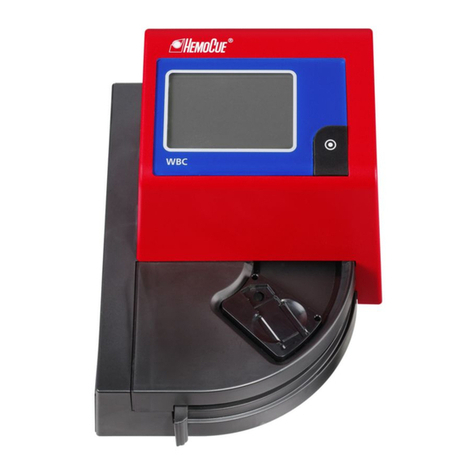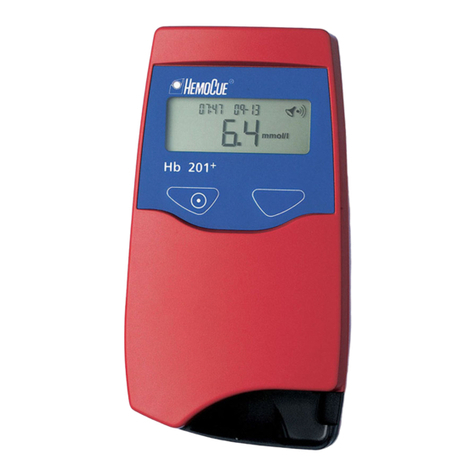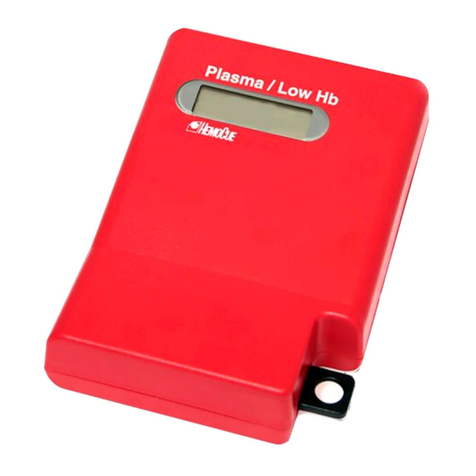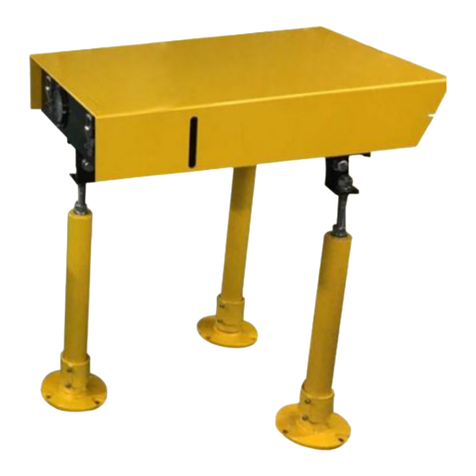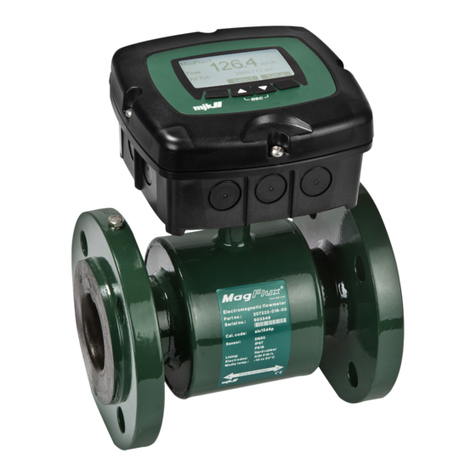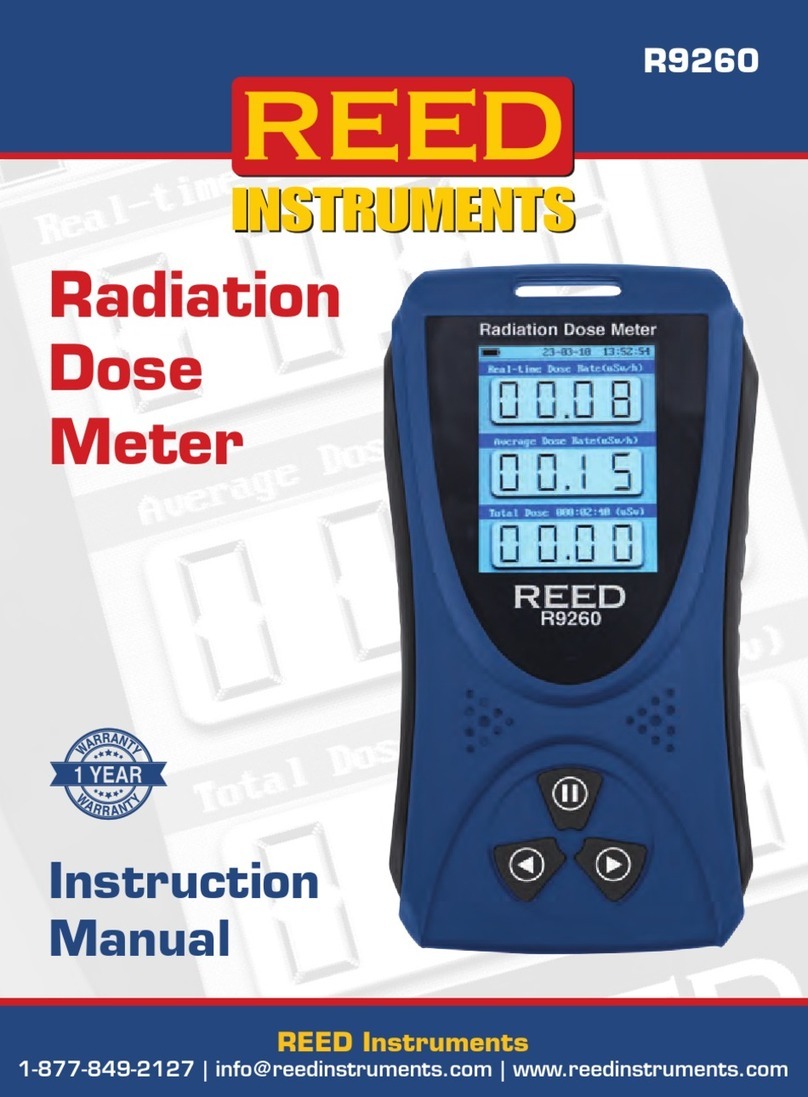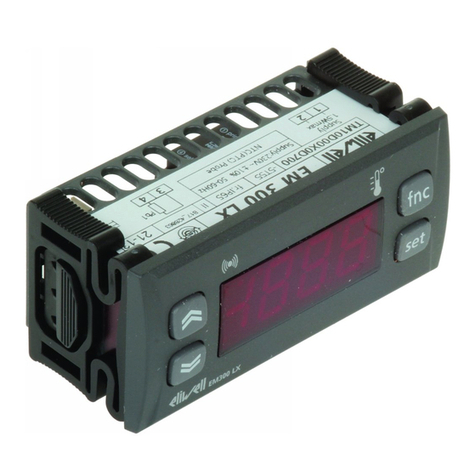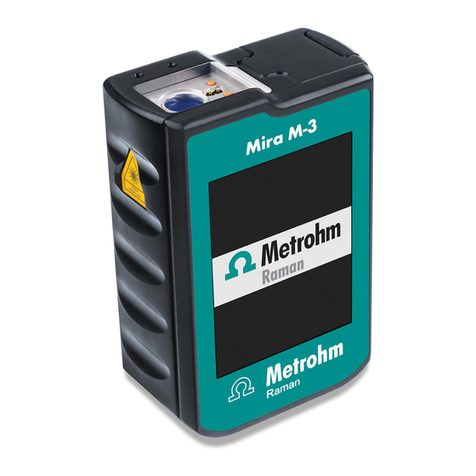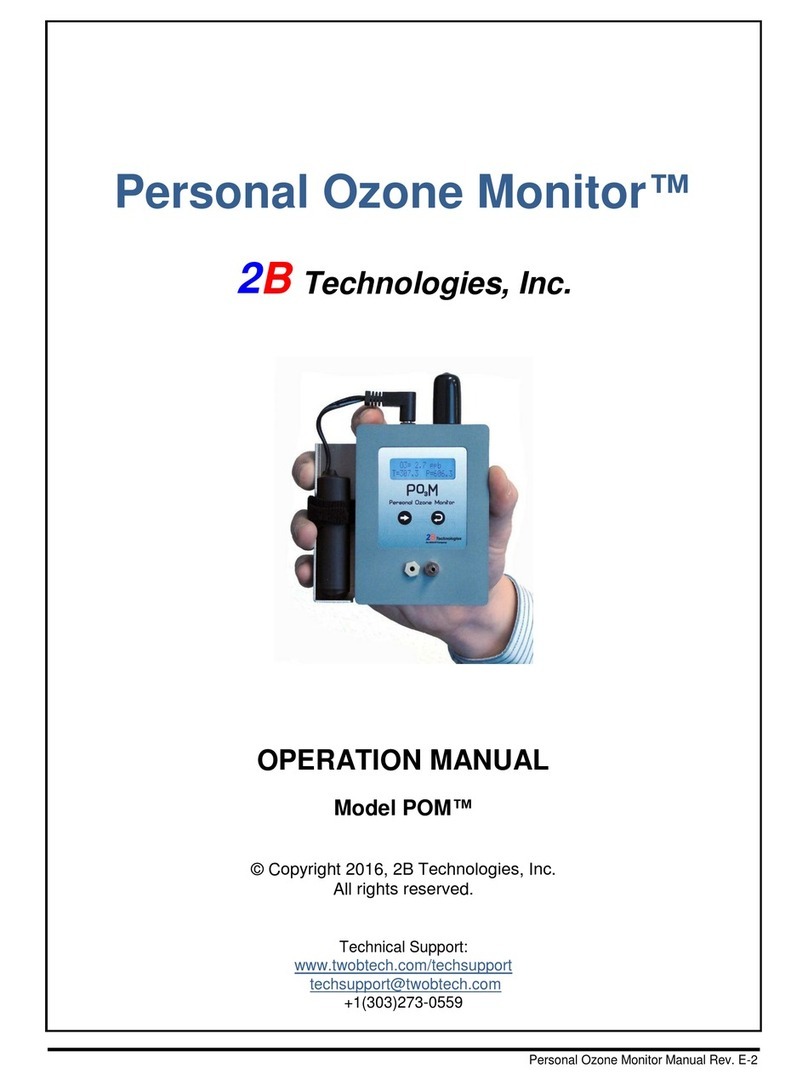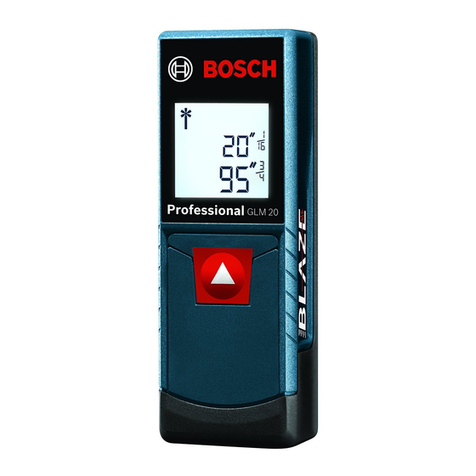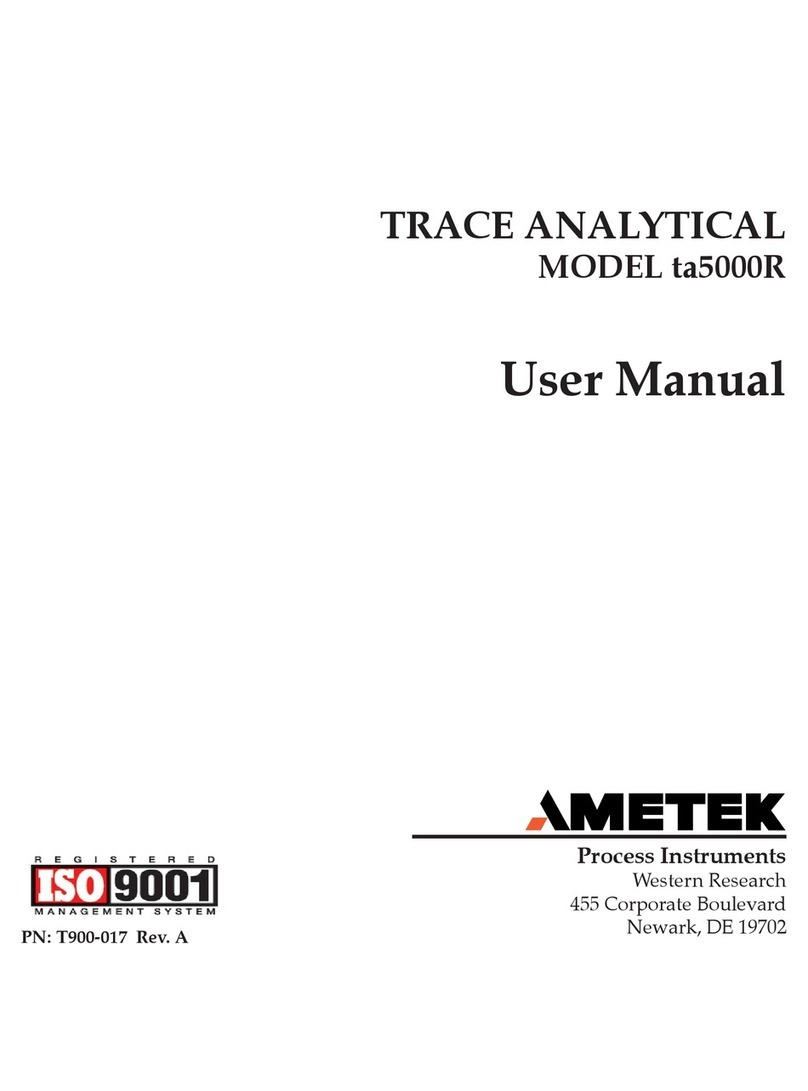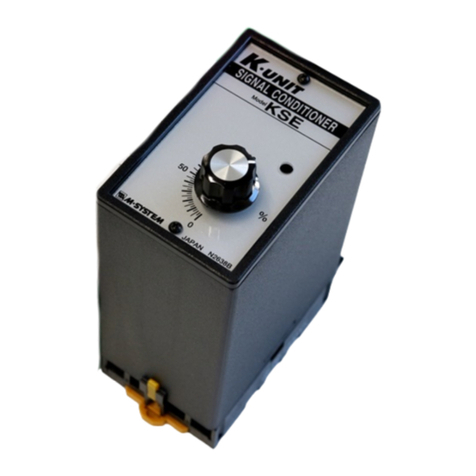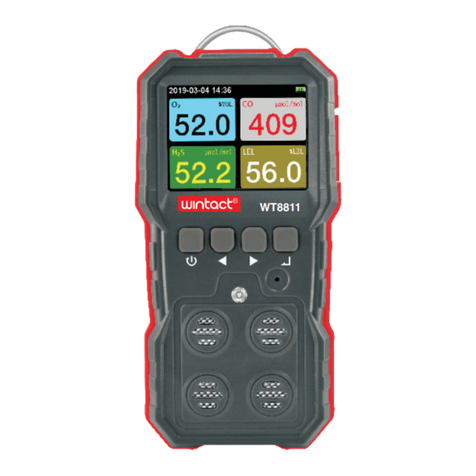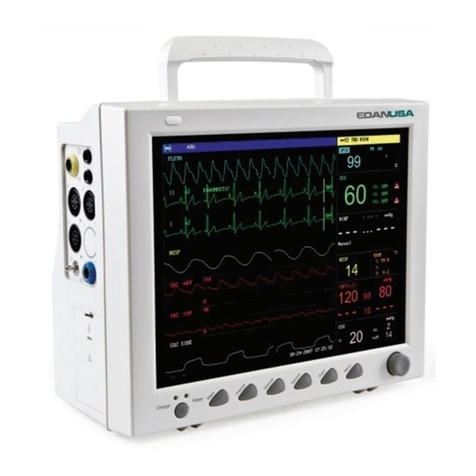HemoCue Hb 201 DM User manual

HemoCue®Hb 201 DM Analyzer
Instructions for Use

CONTENTS
1 Introduction......................................................................................................1
1.1 Unpacking ...........................................................................................................2
1.2 Functional description........................................................................................2
1.2.1 System Components...............................................................................................2
1.2.2 Analyzer overview ....................................................................................................3
2 General operations .........................................................................................6
2.1 Getting started – Analyzer...............................................................................6
2.1.1 Power source........................................................................................................... 6
2.1.2 Turning on the Analyzer ........................................................................................ 9
2.1.3 Power saver mode ................................................................................................ 10
2.1.4 Turning the Analyzer o....................................................................................... 10
2.1.5 Loading the Analyzer with a Cuvette.................................................................11
2.2 Docking Station LED .......................................................................................12
2.3 How to operate the Display...........................................................................13
2.3.1 Display buttons.......................................................................................................13
2.3.2 Using the Barcode Scanner button....................................................................16
2.3.3 Main Menu and Help .............................................................................................17
2.4 Display buttons and symbols ........................................................................18
2.4.1 Navigation buttons.................................................................................................18
2.4.2 Procedure buttons.................................................................................................19
2.4.3 Other display buttons...........................................................................................20
2.4.4 Display symbols..................................................................................................... 22
2.4.5 Entering information with letters and digits.................................................... 24
3 Sampling and Measuring .............................................................................27
3.1 Capillary blood .................................................................................................27
3.2 Control Material, Venous or Arterial Blood ............................................... 30
4 Routine Use....................................................................................................31
4.1 Patient Test Procedure....................................................................................31
4.2 STAT Test Procedure ...................................................................................... 33

4.3 QC Test Procedure......................................................................................... 34
4.4 Stored data....................................................................................................... 36
4.4.1 Reviewing Stored Data......................................................................................... 36
4.4.2 Deleting Stored Data ............................................................................................ 37
4.4.3 Review Latest Download ..................................................................................... 37
4.4.4 Log Input................................................................................................................. 37
5 Maintenance.................................................................................................. 38
5.1 Cleaning the Cuvette holder and the optronic unit................................ 38
5.2 Cleaning the Display ......................................................................................40
5.3 Cleaning of the Analyzer Outer case and the Docking Station ............ 40
5.4 Calibrating the Display....................................................................................41
6 Troubleshooting ........................................................................................... 42
7 Specifications................................................................................................ 47
7.1 Intended purpose/ Intended use................................................................. 47
7.2 Principles of the method and procedure .................................................. 47
7.3 Storage and handling..................................................................................... 47
7.4 Quality Control................................................................................................ 48
7.5 Limitations........................................................................................................ 48
7.6 Expected values .............................................................................................. 48
7.7 EMC and Electrical Safety ............................................................................. 49
7.8 Warranty............................................................................................................ 49
7.9 Service and Disposal ...................................................................................... 49
7.10 Materials required but not provided ........................................................... 50
7.11 Spare parts ....................................................................................................... 50
7.12 Optional items................................................................................................. 50
7.13 Symbols used ...................................................................................................51
7.14 References........................................................................................................ 52
Technical Specifications .................................................................................... 53

1
1 Introduction
Thank you for choosing the HemoCue Hb 201 DM system.
The HemoCue Hb 201 DM system is a compact, portable, yet versatile, hemoglobin
measuring system. It is ideally suited for health care facilities that require central lab
quality values within a few minutes, at the point of care location.
The System consists of the HemoCue Hb 201 DM Analyzer, the HemoCue 201 DM
Docking Station and the HemoCue Hb 201 Microcuvettes.
This Manual contains step-by-step instructions for the routine use of the HemoCue Hb
201 DM Analyzer. For configuration of the Analyzer and set-up of the System, consult
the HemoCue 201 DM Reference Manual. Installation of HemoCue DM Docking Station
has been described in HemoCue 201 DM Docking Station Manual.
The HemoCue Hb 201 DM system complies with the IVD Medical Device Directive 98/79/
EC and carries the CE mark.
Read and follow this operating manual and the HemoCue Hb 201 Microcuvettes
package insert to attain optimum performance and safety. Any other use of the system than
recommended by the manufacturer may impair the safety.
Usage Disclaimer
The HemoCue Hb 201 DM system has flexible settings to meet dierent user needs. The
setting options are configured in the settings menu, requiring a pin code. The selected
settings are the responsibility of the local administrator. HemoCue AB does not take
responsibility for user configurations that may cause system conflicts, loss of data or
prevent the end-user to perform tests.

2
1.1 Unpacking
FIGURE 1-1
a) Open up the package and unpack the
contents on a dry and stable surface.
b) Check all Components for damage. If any
visible or suspected damage is
discovered, contact HemoCue AB or the
local distributor.
1 HemoCue Hb 201 DM Analyzer
2 HemoCue Hb 201 DM Analyzer Instructions for
Use
1.2 Functional description
1.2.1 System Components
FIGURE 1-2
The System consists of a specially designed
Analyzer(1), the HemoCue Hb 201 DM
Analyzer, specially designed Cuvettes(2), the
HemoCue Hb 201 Microcuvettes and a
specially designed Docking Station(3), the
HemoCue 201 DM Docking Station.
Analyzer
The HemoCue Hb 201 DM Analyzer(1) is
only to be used together with the HemoCue
Hb 201 Microcuvettes(2).
The System is intended for In Vitro
diagnostic use only.
1 Analyzer
2 Cuvette
3 Docking Station
Instructions for Use
r
U
se
1
2
3
1
23

3
1.2.2 Analyzer overview
Front panel
FIGURE 1-3
The Analyzer(1) is started when the On/O
button(2) is pressed. The screen images will
be visible on the Display(3).
All navigation and information handling is
performed by pressing the appropriate touch
buttons directly on the Display(3).
To perform a measurement, the Cuvette is
filled with sample material and placed in the
Cuvette holder(4). The Cuvette holder is
inserted into the Analyzer.
To turn o the Analyzer(1), press the On/O
button(2).
1 Analyzer
2 On/O button
3 Display
4 Cuvette holder
1
4
3
2

4
Back panel
FIGURE 1-4
The following items are found on the back
panel of the Analyzer.
• Power inlet(1) for the Power Adapter
• Power + USB signal inlet(2) for
connection to the Docking Station
• Built-in Barcode Scanner(3)
• IR Transmitter/Receiver(4) for data
transfer to/from the Docking Station
The Power inlet(1) for the Power Adapter
can only be used when the Analyzer is out of
the Docking Station. When the Analyzer is
placed in a Docking Station, this inlet will be
blocked and the Analyzer receives power via
the Power + USB signal inlet(2).
1 Power inlet (for Power Adapter)
2 Power + USB signal inlet (for Docking Station)
3 Barcode Scanner
4 IR Transmitter/Receiver
3
4
1
2

5
Placing the Analyzer in the Docking
Station
FIGURE 1-5
Always slide the Analyzer into and out of the
Docking Station by means of the Tracks(1).
Make sure the Analyzer is fully inserted.
Never try to lift the Analyzer out of the
Docking Station or press the Analyzer
downwards into the Docking Station.
This may damage the casing and power
outlets of the Analyzer and/or the Docking
Station.
Remove the Analyzer if there is no
communication between the Analyzer and
the Docking Station and then re-dock the
Analyzer in the Docking Station.
1 Tracks
1

6
2 General operations
This chapter describes the general operations necessary for Analyzer use.
2.1 Getting started –
Analyzer
Always follow the operating and storage
conditions listed under section Technical
Specifications. Allow the Analyzer to reach
operating temperature before use.
2.1.1 Power source
The Analyzer can be powered either by the
rechargeable Battery or by a standard
electrical outlet via the Power Adapter.
Recharging the Battery
FIGURE 2-1
The rechargeable Battery(1) is located in a
battery compartment on the bottom of the
Analyzer.
a) Recharge the Battery(1) by connecting
the Power Adapter to the Analyzer or by
placing the Analyzer in the Docking
Station that is connected to the Power
Adapter. New Battery will take longer to
charge the first 2 to 3 times.
1 Battery
1

7
Replacing the Battery
FIGURE 2-2
Only the HemoCue 201 DM Battery
can be used in the Analyzer.
Lithium-ion battery. Never try to open
the battery casing. Risk of explosion.
The Battery lasts for several years. It should
be replaced when it fails to retain its charge
for an acceptable period. Replace it when
the capacity to hold a charge starts to
deteriorate quickly.
a) To remove the Battery(1), press the
Flap(2). Carefully loosen the Battery(1)
and lift it upwards.
b) To install the new Battery(3), place it in
the Analyzer and gently press downwards
until the Flap(4) snaps into the locked
position.
Consult local environmental authorities for
proper disposal.
1 Old Battery
2 Flap
3 New Battery
4 Flap
1
2
3
4

8
Connecting the Power Adapter
FIGURE 2-3
Only use the Power Adapter listed in
section Technical Specifications. Other
Power Adapters, although physically able to
be plugged into the Analyzer, may cause
serious damage or fire.
a) Insert the Power Adapter’s DC plug(2)
into the Power inlet(3) on the back panel
of the Analyzer.
b) Plug the Power Adapter(1) into an
electrical outlet.
1 Power Adapter
2 DC plug
3 Power inlet
3
1
2

9
2.1.2 Turning on the Analyzer
FIGURE 2-4
a) Turn on the Analyzer by pressing the On/
O button(1).
b) The Start Image, beginning with the
HemoCue logo, will be displayed.
• If the Cuvette holder is in the measuring
position (see FIGURE 2-8), the following
text will be displayed:
Please Pull out The Cuvette Holder
• When the Cuvette holder is in the
Loading position (see FIGURE 2-6),
self-test will be performed. No inputs can
be made for approximately 20 seconds
during the self-test.
1 On/O button
2 Display
2
1

10
2.1.3 Power saver mode
When no procedures have been performed
within the time predefined in the Analyzer
settings, the Analyzer will switch to power
save mode.
If the Analyzer is powered via the Power
Adapter, the user will be logged o, the
image on the display will disappear, but the
power will remain on. Touch the Display to
reactivate it.
If the Analyzer is powered via the Battery, the
user will be logged o and the Analyzer will
be switched o. Press the On/O button to
reactivate it.
2.1.4 Turning the Analyzer o
FIGURE 2-5
Make sure not to turn o the Analyzer in the
middle of a procedure as data may be lost.
a) Turn o the Analyzer by pressing the On/
O button(1). The Display (2) goes blank.
1 On/O button
2 Display
2
1

11
2.1.5 Loading the Analyzer with
a Cuvette
The Loading position
1
FIGURE 2-6
FIGURE 2-6 shows the Analyzer with the
Cuvette holder(1) open, referred to as the
Loading position.
1 Cuvette holder
Inserting a Cuvette
1
FIGURE 2-7
Obtain a blood sample according to the
procedure described in section 3 Sampling
and Measuring.
a) Place the Cuvette in the Cuvette
holder(1) and gently close the Cuvette
holder.
The Analyzer will automatically start the
measuring procedure.
1 Cuvette holder
The Measuring position
1
FIGURE 2-8
FIGURE 2-8 shows the Analyzer with the
Cuvette holder(1) in the closed position,
referred to as the Measuring position.
1 Cuvette holder

12
2.2 Docking Station LED
Green light
1
FIGURE 2-9
A steady green light from the LED indicates
that the Docking Station is receiving power
and that the Battery is fully charged.
A flashing green light from the LED indicates
that the Battery in the docked Analyzer is
charging.
1 LED
Red light
2
FIGURE 2-10
A steady red light from the LED indicates an
internal error within the Docking Station.
A flashing red light from the LED indicates
an external communication error.
The above is only valid for Primary Docking
Stations and SDS+- labelled Secondary
Docking Stations.
See Reference Manual for troubleshooting.
2 LED

13
2.3 How to operate the
Display
2.3.1 Display buttons
Enter
Settings Password
FIGURE 2-11
The Buttons(1) appearing on the Display(2)
activate the specific functions symbolized
by the image on the button.
The Buttons(1) should only be pressed using
the fingertip. Do not use sharp-edged
objects as these can damage the Display.
1 Buttons
2 Display
Activating a function
Enter
Settings Password
1
FIGURE 2-12
a) When a Button(1) is pressed, it will
appear highlighted as long as it is kept
pressed.
b) When the Button is released, the function
indicated by the button is activated. An
audible signal will sound if the audio
function has been activated in the
Settings.
1 Button, highlighted

14
Changing a function
Enter
Settings Password
FIGURE 2-13
a) Keep pressing while moving the fingertip
over to another button.
Enter
Settings Password
FIGURE 2-14
b) The original button will cease to appear
highlighted and the new button will
appear highlighted.
c) When the new Button is released, the
new function will be activated.

15
Cancelling a function
Enter
Settings Password
FIGURE 2-15
a) Keep pressing while moving the fingertip
over to an area without Buttons.
Enter
Settings Password
FIGURE 2-16
b) No Button will appear highlighted.
c) When the finger is released from the
Display, the first Button choice will be
ignored and no action will be activated.

16
2.3.2 Using the Barcode
Scanner button
FIGURE 2-17
Important: Be aware of the laser radiation –
do not stare into the beam.
To read barcodes, use the built-in Barcode
Scanner in the back panel of the Analyzer.
The Scanning range(3) of the Barcode
Scanner, is approximately 10–30 cm (4–12
inches) from the Scanner.
a) Press and hold the Barcode Scanner
button(1). The Barcode Scanner is
activated and scanning can be performed.
b) The decoded information from the
barcode(2) appears on the Display when
the Analyzer identifies the barcode. The
information is displayed as long as the
Barcode Scanner button(1) remains
pressed. To cancel a reading, move the
fingertip to an area outside the Barcode
Scanner Button, before releasing.
c) When information is displayed, remove
the fingertip from the Barcode Scanner
button(1). The information will be stored
in the Analyzer, and is no longer
displayed.
1 Barcode Scanner button
2 Barcode
3 Scanning area
10-30
cm
4-12
inches
Enter
Settings Password

17
2.3.3 Main Menu and Help
FIGURE 2-18
FIGURE 2-18 is referred to as the Main Menu.
It is displayed as the Startup Image for all
Tests, Setting procedures, etc.
The Help button(1) may be used to display
information about other buttons,
procedures, etc.
1 Help button
2 Operator name, Operator ID or blank,
depending on the settings*
* It is recommended to use the Approved Only
setting for operators to ensure optimal operator
traceablity.
08/09/03 10:55 AM
JAMES SMITH
1
Table of contents
Other HemoCue Measuring Instrument manuals
Popular Measuring Instrument manuals by other brands
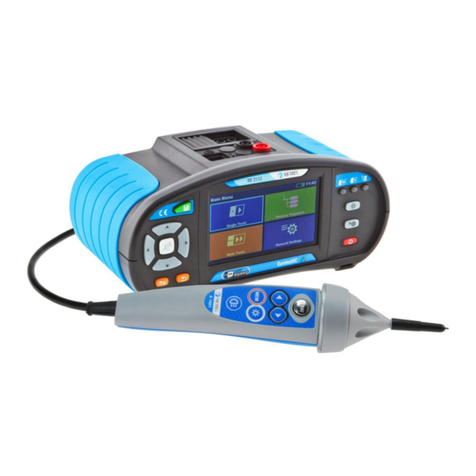
METREL
METREL EurotestXC MI 3152 instruction manual
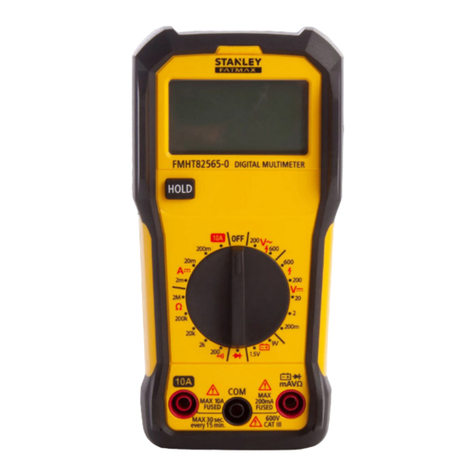
Stanley
Stanley FATMAX FMHT82565-0 instruction manual

Xylem
Xylem FLYGT Start 151 Installation and operation manual

Fuji Electric
Fuji Electric ZPB Insruction manual

Shimpo Instruments
Shimpo Instruments PT-120 Operation manuals

Veto
Veto E5020503 owner's manual

